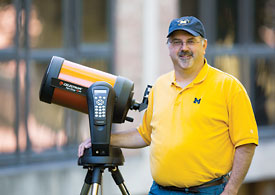When telling people about his job, Jeff Kopmanis says that he works on NASA projects — and he’s not exaggerating.
As an application programmer senior at the Center for Space Environment Modeling in the Department of Atmospheric, Oceanic, and Space Sciences, College of Engineering, Kopmanis works on the websites that host the AOSS scientists’ tools and processes.

Photo by Austin Thomason, Michigan Photography.
“I make the tools accessible to other people through that Web interface. … You have to know about the processes underneath to make a site look pretty for all its users,” Kopmanis says. “I make the Web front-ends (that) make it possible for ordinary people to run these very sophisticated tools.”
Recently, he worked on a website for the Rosetta mission, a European Space Agency spacecraft that will orbit and land on Comet 67P/Churyumov-Gerasimenko, and the Cassini Solstice Mission through NASA, the goal of which is to study Saturn and its moons. The scientists at AOSS “crunch numbers and look at the results coming back from those probes,” says Kopmanis, who creates the scripts that “put up a Web front-end on top of those technical tools.”
“Making sure I’m doing what (the scientists) want and the results are what they need” can be stressful, says Kopmanis, but he loves his job. “I love programming, I love all the technical stuff. … I figured that out in the last few years — do what you like to do and you’ll be a lot better off.”
Although he started at U-M’s Artificial Lab in 1995, Kopmanis started working at the CSEM in February of this year. His experience in the field helps him create Web interfaces for the CSEM scientists’ complicated processes, which mostly focus on the solar wind and its effects on Earth’s magnetosphere.
Kopmanis’ proficiency with computers immensely helped him when he became interested in astronomy and eventually astrophotography. “You can always find some tool to do the job, that’s a career habit from the computing world,” he says about the learning curve he experienced when navigating telescopes. After his wife (and high school sweetheart), Gretchen, gave him his first telescope in 1998 as an anniversary present, he was hooked.
When the weather is good, Kopmanis can be found outside his Ypsilanti home, looking at everything from Jupiter to Orion’s Belt. He finds great joy in observing the sky, and realized that he wants “to show everyone what I’m seeing without having them come over at odd hours of the morning.”
In order to do that, Kopmanis looked into astrophotography. He bought his first camera and began with pictures of the moon and of sunspots. By taking a movie of the object he is looking at, and then using computer programs to process the hundreds of frames into one image, he can distill clear images of objects in space with more details.
Astrophotography is a learning process, Kopmanis explains, but it’s completely worth it. “When you see a moon go behind a planet, and you’re watching it live, you are just blown away. … When I see something cool, I want to share that with everyone.” He started the Orange Can Astronomy Blog to do just that.
Kopmanis also volunteers in the community by writing Web pages for the community cleanup group, YpsiPRIDE (People Restoring Image and Developing the Environment), and contributing database work for the Monroe High School Alumni Association. He also plays saxophone in two groups, the Monroe Big Band and The Soul Kitchen Band.
The weekly Spotlight features faculty and staff members at the university. To nominate a candidate, please contact the Record staff at [email protected].

